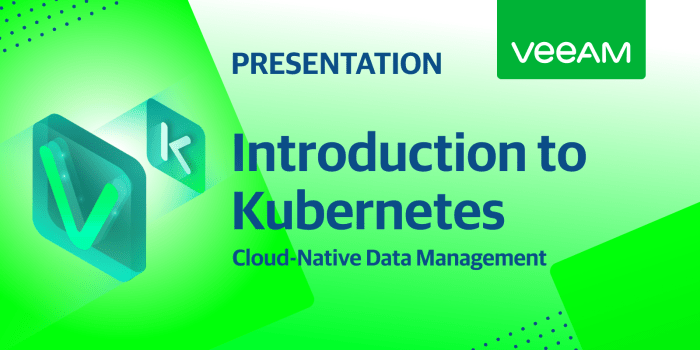Delving into Cloud-native data management, this introduction immerses readers in a unique and compelling narrative, with a concise overview of defining cloud-native data management, exploring its key principles, and discussing the benefits of its practices.
In the following sections, we will delve into the essential components, challenges, best practices, and real-world examples of cloud-native data management to provide a comprehensive understanding of this crucial topic.
Overview of Cloud-Native Data Management

Cloud-native data management refers to the practice of managing and storing data in a way that is optimized for cloud environments. This approach involves leveraging cloud-native technologies and services to efficiently handle data processing, storage, and retrieval.
Key Principles of Cloud-Native Data Management
- Scalability: Cloud-native data management allows for seamless scalability, enabling organizations to easily adapt to changing data needs without disruption.
- Resilience: Data is distributed across multiple cloud instances to ensure high availability and fault tolerance, reducing the risk of data loss.
- Elasticity: The ability to dynamically adjust resources based on workload demands, ensuring optimal performance and cost-efficiency.
- Automation: Automation of data management processes reduces manual intervention, improves efficiency, and minimizes errors.
- Security: Robust security measures are implemented to protect data from unauthorized access, ensuring compliance with data protection regulations.
Benefits of Adopting Cloud-Native Data Management Practices
- Cost Efficiency: Cloud-native data management reduces infrastructure costs by eliminating the need for on-premises hardware and maintenance.
- Flexibility: Organizations can easily adjust storage and processing capabilities based on changing business requirements, ensuring agility and adaptability.
- Scalability: Cloud-native solutions enable seamless scalability to accommodate growing data volumes and user demands without downtime.
- Improved Performance: By leveraging cloud-native technologies, data management processes can be optimized for speed and efficiency, enhancing overall performance.
- Data Accessibility: Cloud-native data management facilitates easy access to data from anywhere, enabling real-time insights and decision-making.
Components of Cloud-Native Data Management

When it comes to cloud-native data management, there are several essential components that play a crucial role in ensuring the effective storage, access, and utilization of data in a cloud environment. These components work together to streamline data operations, enhance scalability, and improve overall efficiency in managing data.
Data Storage in a Cloud-Native Environment
In a cloud-native environment, data storage is managed through a combination of distributed storage systems, data replication, and data partitioning techniques. These components help ensure high availability, fault tolerance, and scalability of data storage, allowing organizations to store and access large volumes of data efficiently.
- Distributed Storage Systems: Cloud-native data management leverages distributed storage systems such as Amazon S3, Google Cloud Storage, or Azure Blob Storage to store data across multiple servers and locations. This approach ensures redundancy, fault tolerance, and seamless access to data.
- Data Replication: Data replication involves creating and maintaining multiple copies of data across different storage nodes or data centers. This redundancy helps prevent data loss due to hardware failures or disasters and ensures data availability even in the event of failures.
- Data Partitioning: Data partitioning involves dividing large datasets into smaller, more manageable partitions that can be stored and processed independently. This approach helps improve data processing performance, scalability, and parallelism by distributing data across multiple nodes or clusters.
Role of Automation in Cloud-Native Data Management
Automation plays a crucial role in cloud-native data management by streamlining data operations, reducing manual intervention, and improving overall efficiency. Through automation, organizations can automate routine tasks, data workflows, and data provisioning processes, allowing them to focus on more strategic initiatives and data-driven decision-making.
- Automated Data Backup and Recovery: Automation tools enable organizations to schedule regular data backups, replicate data across multiple locations, and automate data recovery processes in case of failures. This helps ensure data integrity, availability, and resilience in the face of unexpected events.
- Automated Data Lifecycle Management: Automation tools can help organizations manage the entire data lifecycle, from data ingestion and processing to archiving and deletion. By automating data retention policies, organizations can ensure compliance with data regulations, optimize storage costs, and maintain data quality over time.
- Automated Data Monitoring and Alerting: Automation tools can monitor data quality, performance metrics, and system health in real-time, triggering alerts and notifications in case of anomalies or issues. This proactive approach helps organizations identify and address data-related issues before they impact operations or service levels.
Challenges in Cloud-Native Data Management
Cloud-native data management comes with its own set of challenges that organizations need to address to ensure smooth operations and data protection.
Scalability Issues and Solutions
One of the main challenges in cloud-native data management is ensuring scalability to handle large volumes of data efficiently. As data continues to grow exponentially, traditional data management approaches may struggle to keep up. Organizations need to implement scalable solutions that can dynamically adjust resources based on demand. This can involve utilizing cloud services that offer auto-scaling capabilities or implementing containerization technologies like Kubernetes to manage resources effectively.
When it comes to Big Data storage solutions , businesses are constantly seeking innovative ways to manage and store vast amounts of data efficiently. One popular option is utilizing NoSQL databases, which offer flexibility and scalability to handle the ever-growing volume of information. Additionally, for more structured data management, companies often turn to Cassandra data management , a reliable choice for handling large datasets with high availability and fault tolerance.
Data Security Concerns in Cloud-Native Environments
Security is a top concern when it comes to managing data in the cloud. Cloud-native environments introduce new security risks, such as data breaches, data loss, and unauthorized access. Organizations need to implement robust security measures to protect sensitive data. This can include encryption of data both at rest and in transit, implementing access controls and identity management, regular security audits, and compliance with data protection regulations such as GDPR or HIPAA.
When it comes to managing large amounts of data, businesses need reliable Big Data storage solutions to ensure efficiency and scalability. One popular option for data management is Cassandra , a NoSQL database that offers high availability and fault tolerance. In the world of databases, NoSQL databases are becoming increasingly popular due to their flexibility and ability to handle unstructured data.
Best Practices for Cloud-Native Data Management
Implementing best practices is crucial for effective cloud-native data management. This ensures that data governance is maintained, data processing and analytics are optimized, and monitoring/logging are in place to ensure data integrity and security.
Implementing Data Governance
- Establish clear data ownership and responsibilities within the organization.
- Implement access controls and data encryption to protect sensitive information.
- Regularly audit data usage and access to ensure compliance with regulations.
- Define data quality standards and processes for data validation and cleansing.
Optimizing Data Processing and Analytics
- Utilize cloud-native tools like Apache Spark or Amazon EMR for scalable data processing.
- Implement data pipelines to automate data ingestion, transformation, and analysis.
- Leverage serverless computing for cost-effective and efficient data processing.
- Use data caching and indexing techniques to optimize query performance.
Importance of Monitoring and Logging
- Set up real-time monitoring for data pipelines to detect and address issues promptly.
- Implement centralized logging to track data access, changes, and system events.
- Utilize anomaly detection algorithms to identify potential security threats or data breaches.
- Regularly review logs and monitoring data to identify trends and areas for improvement.
Case Studies and Examples
In this section, we will explore real-world examples of organizations that have successfully implemented cloud-native data management and the impact it has had on their agility, innovation, disaster recovery, and business continuity.
Organization A: Retail Industry
- Organization A, a leading retail company, adopted cloud-native data management solutions to streamline their data storage and processing.
- By leveraging cloud-native technologies, Organization A was able to scale their operations efficiently during peak seasons and handle large volumes of customer data seamlessly.
- This implementation significantly improved their agility, allowing them to respond quickly to changing market demands and customer preferences.
Organization B: Financial Services Sector
- Organization B, a prominent player in the financial services sector, integrated cloud-native data management into their systems to enhance data security and compliance.
- Cloud-native data management enabled Organization B to create robust disaster recovery and business continuity plans, ensuring minimal downtime in case of any unforeseen events.
- As a result, Organization B experienced improved operational resilience and the ability to innovate with confidence, knowing their data was protected and readily accessible.
Organization C: Technology Startup
- Organization C, a fast-growing technology startup, utilized cloud-native data management solutions to accelerate their product development cycles and improve time-to-market.
- By storing and processing data in the cloud, Organization C could focus on innovation and experimentation without being limited by traditional data infrastructure constraints.
- This approach allowed Organization C to quickly adapt to market changes, launch new features, and stay ahead of competitors in a highly dynamic industry.
In conclusion, Cloud-native data management presents a paradigm shift in how organizations handle data, offering scalability, efficiency, and enhanced security measures. By implementing best practices and learning from successful case studies, businesses can leverage cloud-native data management to drive innovation and ensure continuity in the face of challenges.



